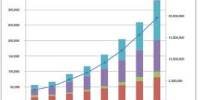In financial economics, a liquidity crisis refers to an acute shortage of liquidity. It is a financial situation characterized by a lack of cash or easily-convertible-to-cash assets on hand across many businesses or financial institutions simultaneously. When short-term interest rates rose and real estate prices collapsed, such arrangements forced a liquidity crisis. It is a shortage of cash and other immediately available funds to meet financial needs such as repayments or urgent spending or fundings.
It can refer to various types of liquidity including funding, market, and accounting liquidity. Liquidity may refer to market liquidity (the ease with which an asset can be converted into a liquid medium, e.g. cash), funding liquidity (the ease with which borrowers can obtain external funding), or accounting liquidity. Certain economists state that a market is liquid if it can consume liquidity trades without large shifts in price. Additionally, some economists define a market to be liquid if it can absorb “liquidity trades” without large changes in price. This shortage of liquidity could reflect a fall in asset prices below their long-run fundamental price, deterioration in external financing conditions, reduction in the number of market participants, or simply difficulty in trading assets. At the root of a liquidity crisis are widespread maturity mismatching among banks and other businesses and a resulting lack of cash and other liquid assets when they are needed.
The above-mentioned forces mutually reinforce each other during a liquidity crisis. Market participants in need of cash find it hard to locate potential trading partners to sell their assets. Liquidity problems can occur at a single institution, but a true liquidity crisis usually refers to a simultaneous lack of liquidity across many institutions or an entire financial system. This may result either due to limited market participation or because of a decrease in cash held by financial market participants. Thus asset holders may be forced to sell their assets at a price below the long term fundamental price. Borrowers typically face higher loan costs and collateral requirements, compared to periods of ample liquidity, and unsecured debt is nearly impossible to obtain. Typically, during a liquidity crisis, the interbank lending market does not function smoothly either. Individual financial institutions are not the only ones who can have a liquidity problem. It can affect banks, financial markets, businesses, States, or even the whole economy bringing a domino/systemic crisis.
Liquidity crises can be triggered by large, negative economic shocks or by normal cyclical changes in the economy. It can occur in banks when there is a shortfall of money to go around. At the core of the liquidity crisis is the fractional reserve banking system. Several mechanisms operating through the mutual reinforcement of asset market liquidity and funding liquidity can amplify the effects of a small negative shock to the economy and result in a lack of liquidity and eventually a full-blown financial crisis. This means that banks can use a large part of their assets into issuing loans and also creating various financial products. It can unfold in response to a specific economic shock or as a feature of a normal business cycle.
















